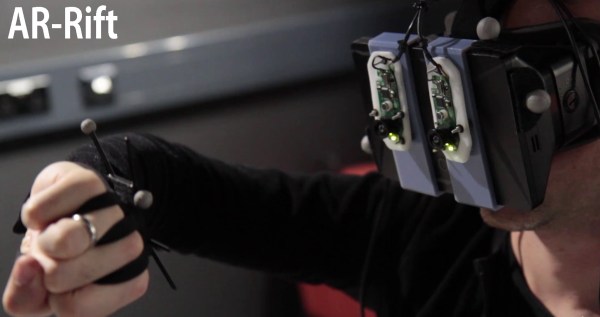[William Steptoe] is a post-doctoral research associate at University College London. This means he gets to play with some really cool hardware. His most recent project is an augmented reality update to the Oculus Rift. This is much more than hacking a pair of cameras on the Rift though. [William] has created an entire AR/VR user interface, complete with dockable web browser screens. He started with a stock Rift, and a room decked out with a professional motion capture system. The Rift was made wireless with the addition of an ASUS Wavi and a laptop battery system. [William] found that the wireless link added no appreciable latency to the Rift. To move into the realm of augmented reality, [William] added a pair of Logitech C310 cameras. The C310 lens’ field of view was a bit narrow for what he needed, so lenses from a Genius WideCam F100 were swapped in. The Logitech cameras were stripped down to the board level, and mounted on 3D printed brackets that clip onto the Rift’s display. Shapelock was added to the mounts to allow the convergence of the cameras to be easily set.
Stereo camera calibration is a difficult and processor intensive process. Add to that multiple tracking systems (both the 6DOF head tracking on the Rift, and the video tracker built-in to the room) and you’ve got quite a difficult computational process. [William] found that he needed to use a Unity shader running on his PC’s graphics card to get the system to operate in real-time. The results are quite stunning. We didn’t have a Rift handy to view the 3D portions of [William’s] video. However, the sense of presence in the room still showed through. Videos like this make us excited for the future of augmented reality applications, with the Rift, the upcoming castAR, and with other systems.
Continue reading “Oculus Rift Goes From Virtual To Augmented Reality”











